Click here for
Einstein's E = mc2 derivable from the Heisenberg brackets.
|
While Einstein was in Copenhagen
Einstein went to Copenhagen and stayed there at the invitation of
Niels Bohr.

|
|
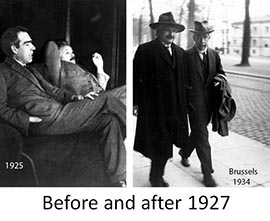
|
|

|
|
I had a photo with one of these Nobels in June of 2015. His
name is Ben Mottelson.
|
|
|
|

|
|
Mottelson was born in U.S.A. and he
received his PhD degree from Harvard in 1950. His advisor was Julian
Schwinger.
|
|
|
|
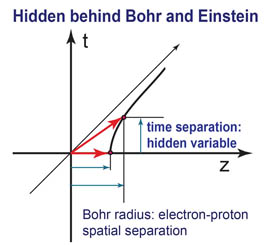
|
- When and how long? I do no know. I hope I can type in exact
numbers later.
He stayed in this building
known as the NBI (Niels Bohr Institute). The third floor of this
building was used as hotel rooms for visiting physicists during
the period 1920-1940,
while Americans were doing Newtonian mechanics in USA.
Bohr's
residence was next to this building.
The list of visitors is very long, including Heisenberg, Dirac, Pauli,
as well as Einstein. Here are the
photos of some of those visitors. One of those photos contains
images of Bohr, Dirac, and Heisenberg.
- Even though Einstein never liked the Copenhagen interpretation of
quantum mechanics, it is safe to assume that Bohr and Einstein
discussed physics. What did they talk about? It is possible that
they talked about their own respective issues.
Bohr was interested in the electron orbit of the hydrogen atom,
while Einstein was interested in how things look to moving observers.
Then how would the hydrogen atom look to a moving observer?
- This is a well-defined problem understandable to every undergraduate
physics major. Einstein and Bohr could have talked about this
subject because they did not have to get into the debate over the
Copenhagen interpretation.
-
John S. Bell was and still is a giant in the Copenhagen debate.
For a Lorentz-boosted hydrogen atom, he included a figure like this
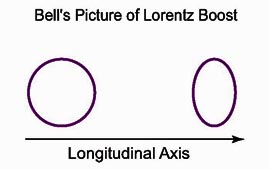
in his book entitled
Speakable and Unspeakable in Quantum Mechanics (1988).
- Unfortunately, this picture does not take into account the fact
that the electron orbit was replaced by a standing wave in 1927.
- You may also ask about a Lorentz-covariant picture of the Bohr
radius. Its longitudinal component picks up a time-like component
according to Einstein. Click here for details.
- Bell used Newtonian mechanics to explain the hydrogen atom of 1988.
On the other hand, with this picture,
he transformed the old problem of Bohr and Einstein into a
new research subject. Bell left us in 1990.
Indeed, the problem of moving hydrogen atoms has been my primary
interest in physics since 1956. I was an undergraduate student (1954-58)
at the Carnegie Institute of Technology (now called CMU or Carnegie
Mellon University). It is still my main business.
- Inside the NBI building during my visit in June of 2015, I asked
young physicists whether Bohr and Einstein ever discussed the
moving hydrogen atom. They all said they do not know, even though
they clearly understood my question.
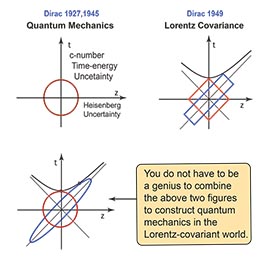
|
|
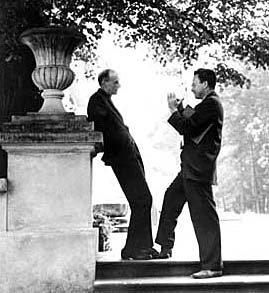
|
Dirac and Feynman in Poland,
Poet and Cartoonist (1962).
|
|
|
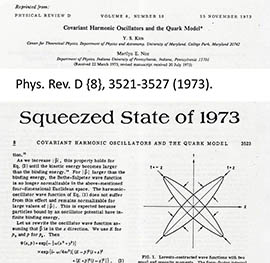
|
However, one of them told me Paul A. M. Dirac worked on this
problem, and told me to read his papers. This young man did not
want to spend any more seconds to entertain my stupid question.
He ran away from me.
- As far as Dirac is concerned, I made a major investment in
decoding what he said in his papers. His papers are like poems,
and I translated his poems into cartoons. Here is
one of my cartoons.
- In 1962, I was fortunate enough to talk with Dirac for 30 minutes.
It was like Nicodemus meeting
with Jesus. Dirac said American physicists should spend
more time for understanding Lorentz covariance.
Dirac did not talk to too many people, but it was three months
after he met Feynman in Poland.
Thus, he was talking about Feynman while mentioning American
physicists.
- I then started studying Dirac's papers on this subject. In 1973,
I realized that Dirac's light-cone coordinate system allows us to
convert the hyperbolic geometry of Lorentz boosts into an elliptic
geometry. With Marilyn Noz, I published a
paper on Lorentz-squeezed hadrons.
In his 1949 paper, Dirac suggested the variables (z + t) and
(z - t). In terms of these variables, the transformation
matrix is diagonal for Lorentz boosts. Let us write
z2 - t2 = (z + t)(z - t) = constant,
which converts
If (z + t) becomes larger, (z - t) should become
smaller. This is a high-school algebra, which I learned in
1949. I learned in 1953 (still in high school) that this can
squeeze a circle into an ellipse.
- If Bohr and Einstein never discussed moving hydrogen atoms, there
is a good excuse. The hydrogen atom moving with a relativistic
speed was far beyond their imagination. Still there are no hydrogen
atoms moving fast enough to show their relativistic effects.
- In 1964, Gell-Mann invented the quark model where the
proton is a bound state of the quarks. The quarks are not electrons,
but the proton and the hydrogen atom share the same quantum
mechanics.
Unlike the hydrogen atom, the proton can be accelerated to the
speed very close to that of light. In 1969, Feynman observed that
the proton appears like a
collection of partons whose properties appear to be quite
different from those of the quarks.
- Thus, the question is whether the quark model and the parton model
are two limiting cases of one Lorentz-covariant entity, just like
Einstein's energy-momentum relation giving two different limits:
- E = p2/2m for slow particles, and
- E = cp for fast
particles.
Let us look at the following table.
| |
Energy
Momentum |
E=p2/2m |
Einstein's
E=(m2 + p2)1/2 |
E = cp |
|
Helicity
Spin, Gauge |
S3
S1
S2 |
Wigner's
Little Group |
S3
Gauge Trans. |
|
Hadrons,
Bound States |
Gell-Mann's
Quark Model |
One
Lorentz-Covariant
Entity |
Feynman's
Parton Picture |
|
This table is from
my PRL paper published in 1989.
Because I made a contribution to the 3rd row of the above table,
I am known as Wigner's student in the physics community.
Click here for the story.
|
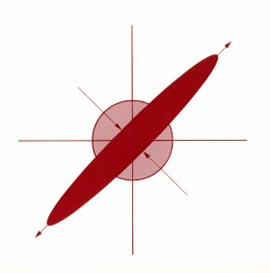
|
|
You have seen this picture before.
|
- Since I derived this picture
from Dirac's papers,
many people ask me
How is the squeezed state these days?
whenever they see me. From now on, they should ask me
How is the hydrogen atom
these days?
Click here for the Lorentz-boosted
hydrogen atom as a further content of Einstein's
E = mc2 .
- I have made many Bohr pages in the past. You may be
interested in some of the following pages.

|
|
Bohr's grandson is next to me, and his great grandson
(College Park, MD, USA, 2014).
|
|
- Bohr and Kirkegaard. Bohr's
philosophical background.
- Bohr's grandson talks about
him. Bohr became an oriental philosopher.
- Bohr's hydrogen atom. 100
years from 1913 to 2013.
- Evolution of the hydrogen atom.
- Bohr and Einstein, and
their hidden variable.
- Heisenberg talks about
Einstein, including his visit to Einstein's house in 1954.

|
| 2015 and 1903 |

|
|

|
The young lady sitting next to me
went to Bohr's high
school.
|
- Copenhagen is an interesting city. For high school boys and girls,
their graduation is a big event. They roam around the streets on trucks
making noises.
- Some of them hijck
army trucks.
- I was invited to one of
their trucks to join the celebration in 2015. My own graduation
day was in 1954.
- Even though I am as old as their grandfathers, I always
enjoy mixing up with
them wherever I go.
- How did Bohr look on his graduation day?
Click here.
- Danish Student in Athens
(July 2008). She studies Greek history in Athens.
This Danish student is sitting next to me, and the other lady is
her Greek friend. This photo was taken at the Agora Market place.
I went there to produce
this page about Socrates.
She was very proud to
tell me that she is a graduate of the high school where Niels Bohr studied.
Bohr spent his elementary and high-school years at the
Gammelholm School System, but this system was abolished four years after
Bohr's graduation. The campus buildings are still used for schools with different
names.
- While visiting copenhagen in June 0f 2015, I was told independently
by two informed Copenhageners that Bohr spent his final high-school years
at the high school now called "Rysenstens Gymunasium." I went there to
take this photo of the school
building.
Click here
for the rest of Copenhagen
I go to Copenhagen fairly often, because it is one of the major transportation
centers in Europe. I take photos there and keep adding them to my Copenhagen page.
- copyright@2019 by Y. S. Kim, unless otherwise specified.
Photos of Bohr and Einstein are from the AIP Emilio Segre Visual Archives.
Photo of Feynman and Gell-Mann is from the Caltech Photo Archives.
- Click here
for his home page.
- His Einstein page.
- Princeton page.
- His stories.
|